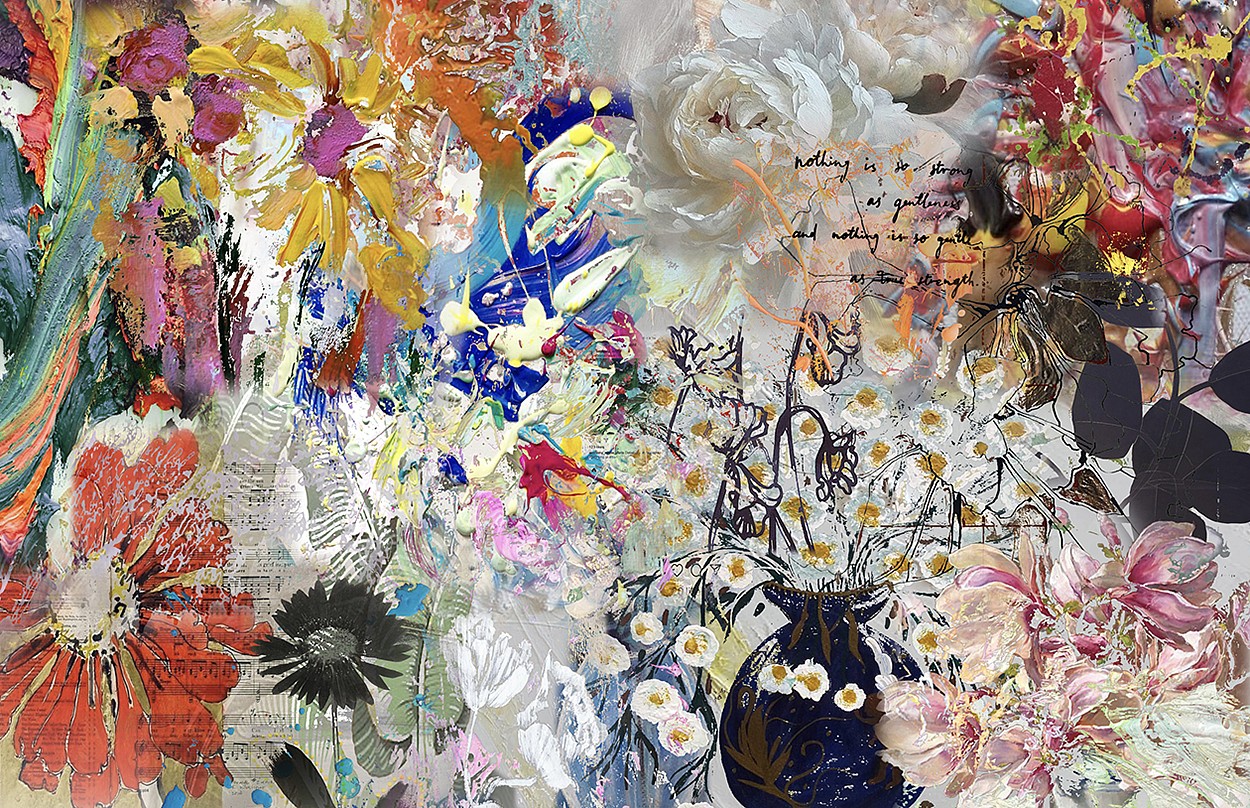PRESS RELEASE

Irene Mamiye: "Homage"
Jul 6 – Jul 29, 2018
BIOGRAPHY
Born in Marseille, France. Lives and works in New York, NY
ABOUT
Irene Mamiye is a New York based artist whose work incorporates photography, video, and digital imaging techniques. With light, color and movement, Mamiye blurs the distinctions between physical and virtual reality. Influenced by her own personal history and artists as diverse as Laszlo Moholy Nagy and Gerhard Richter, Mamiye employs intricate and labor intensive processes to challenge what is expected of the photographic medium. Culling photographs from social media, Mamiye transforms the plenitude of public images into richly layered works that hint at a life lived between screens. With a playful yet mordant humor, Mamiye creates pieces packed with art historical depth and pop cultural abundance.
Mamiye’s extensive body of work, including digital images, videos, and furniture designs, has been widely exhibited across the United States. Her work was included in the landmark exhibition The Edge of Vision (2009), mounted by the Aperture Foundation, and in the Museum of Art and Design’s Multiple Exposures: Jewelry and Photography (2014). Mamiye’s work has also been featured in the following publications: Architectural Digest, Interior Design Magazine, Vanity Fair, People Magazine, Elle Décor and InStyle.
Irene Mamiye was born in Marseille, France and immigrated to the U.S as an adolescent. She holds a BA in Photography and Global Studies from Gallatin New York University and an MFA in Lens Arts from the School of Visual Arts in New York.
PUBLIC COLLECTIONS
CBS Television
Calvin Klein, New York, NY
Cassa Hotels/MMC Design Group, New York, NY Consolidated Design Studios, New York, NY
Federated Department Stores, New York, NY
F-Factor, New York, NY
Gallatin School of Study, NYU, New York, NY
National September 11 Memorial and Museum, New York, NY SaraMax Apparel Group, New York, NY
Sephardic Community Center, Brooklyn, NY
Sumitomo Corporation of America Headquarters, Houston, TX Thor Equity, New York, NY
Wynn Hotels, Macau, Hong Kong
ARTIST STATEMENT
Digital screens have taken over our time, attention and the way we perceive reality. We continue to depend on photography as the medium to record a truth at the very moment when fidelity to any prior reality has never been more questionable. Virtual tours sell real estate and hotel rooms; Ebay, Amazon and Google are photo-based outlets to sell products. Social media have promoted a paradoxical ideal of instant transparency and of experimentation for self/expression. Alone at the screen we seek connection, yet we are aware of software that can seamlessly distort the images we capture. And with every scroll our eyesight expands its dominion over our other senses of touch, taste, hearing and smell.
The expansion of this intermedia zone has given tremendous urgency to the investigation of two and three-dimensional relations and, in art, the relation between eye, hand, mind and object. I consider myself among a new generation of artists probing these relations. I pursue a variety of strategies using digital software to appropriate and alter images from an array of different sources, including Instagram posts and widely trafficked renderings of iconic works of art.
To highlight the process of continuous translation and transformation across platforms, I focus on abstraction, employing software programs designed to create imagery to transform Instagram posts into elaborate and visually complex nonrepresentational “canvases.” The images I produce carry many associations with high modernist art, including a variety of approaches associated with geometric abstraction. The results deliberately contradict not only the realist character of much of the source imagery but also the idea of indexical transparency supporting Instagram and similar platforms.
In a recent series, for example, I have investigated the character of Ellsworth Kelly’s minimalism as it is represented in digital space by subjecting Instagram posts of his work to mathematically based tools. The result is a new set of “Kellys” that comment on the ambitions of his and other minimalist works, paying homage to their precision and exploring their aesthetic attraction. In a sense, I recover these icons from
their ungrounded state as digital phantoms, where they are unstable, existing in wildly various resolutions, sizes and hues.
These are new works that begin where the paintings leave off -- in every way. I know that they are only fixed in a physical output, which is another decision I make, and that in digital space they are subject to the same or other degradations and manipulations. Needless to say, my approach also raises issues of ethics and fair use, at a time when appropriation is ripe for re-interpretation. Likewise, my work is a Duchampean idea of the readymade in the constant free flow of images.
In my work, I seek to illuminate the changing relationship between process and output. The tsunami of digital image generation and the spread of photographic interchange (which has created an environment of sourceless visual material) have conspired to banish the body from production and aesthetic engagement. My work reveals a more complex situation. While other artists such as Daniel Gordon and Yamini Nayar refer to a stage of sculpture or physical collage in their photographic productions, I use digital programs as if they were physical tools. Distorting, assembling, layering, feathering, scaling and changing opacity are my paintbrushes and the found imagery is my paint. This process deliberately reintroduces familiar strategies of chance, subconscious response and even physical gesture that the computer is conventionally supposed to have banished. Likewise, the resulting outputs (pigment print on canvas, diasec, paper and even glass) explore experiences of surface pioneered by modern artists and flattened to nothingness in a digital age.
